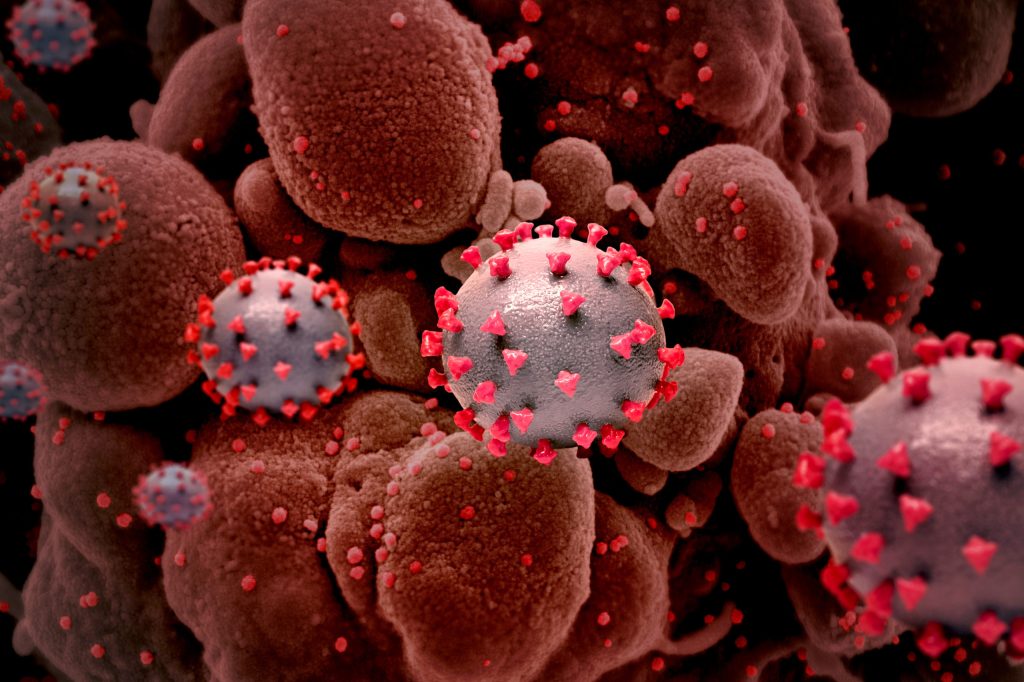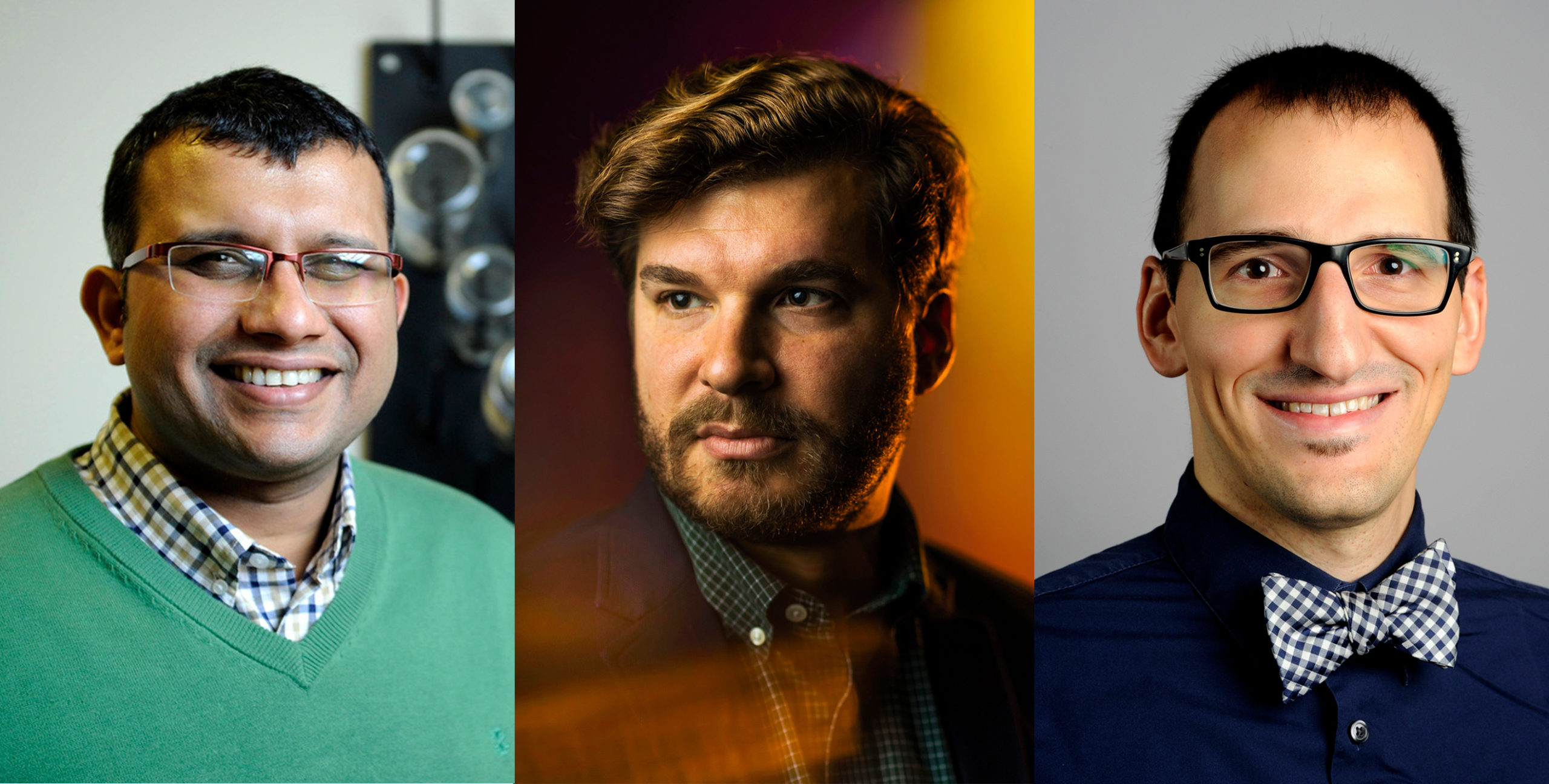Scientists still don’t have all the answers about the coronavirus–and that’s a sign of progress

Seven months into the pandemic, U.S. government officials and scientists still disagree over basic safety guidance on the coronavirus. People are still disregarding key public health advice. And we are still seeing leading public health organizations revise their understanding of the SARS-CoV-2 coronavirus, which causes COVID-19.
But the fact that messaging from public health and scientific experts has changed during the pandemic is a sign of progress—and not completely unexpected, says Samuel Scarpino, an assistant professor who runs the Emergent Epidemics Lab at Northeastern.

From left to right: Ameet Pinto, an assistant professor of civil and environmental engineering; Samuel Scarpino, an assistant professor who runs the Emergent Epidemics Lab at Northeastern; and Brandon Dionne, an assistant clinical professor of pharmacy and health systems sciences. Photos by Northeastern University
Before the pandemic, scientists knew of several other types of coronaviruses that could infect humans. But until SARS-CoV-2 began to make people sick, scientists had never needed to study how this particular virus attacks the human body.
“By the very nature of emerging and infectious diseases,” Scarpino says, “sometimes you’re going to be right and sometimes you’re going to be wrong.”
Now, as researchers study SARS-CoV-2 and COVID-19 at breakneck speeds, one key aspect to keep in mind is that the research is happening while everyone watches, Scarpino says.
“The public is getting front-row seats to the scientific method, probably in a way they never imagined they would’ve experienced,” he says, “or at least in a way that so many individuals are interested because it affects their day-to-day lives so acutely.”
It wasn’t until April that the U.S. Centers for Disease Control and Prevention started recommending that everyone in public wear simple cloth materials to cover their face. The revised recommendations came about because of new evidence on how easily the coronavirus spreads among people, as well as reports of people who can carry and pass the virus without showing symptoms of being sick.
Most public health experts and researchers have tried to be as clear as possible in communicating their findings and recommendations, underscoring that with an emerging disease such as COVID-19, more details about the coronavirus might come to light with further research.
But that message doesn’t always get across to everyone, says Brandon Dionne, an assistant clinical professor of pharmacy and health systems sciences.
Dionne says that during a time when researchers are racing to find answers, everyone should commit to communicating the implications of public health recommendations as accurately as possible—and to present that messaging in the right context, which involves certain levels of uncertainty about a new virus.
That’s because sometimes, the early message is what sticks with people.
“We need to learn how to more effectively communicate and distill things down when you have better science—making it clearer and say that, yes, that was our best understanding at the time, but this is more definite now,” Dionne says. “That’s exactly how science works.”
That idea may be easy to grasp for someone like Dionne, who spent about a decade studying biology, pharmacy, and infectious diseases. But to the uninitiated, it might not be as clear.
The short story is that science is a messy process.
Generally speaking, the scientific method is how biologists, astrophysicists, and all other kinds of scientists, investigate unexplained phenomena and mysteries about this and other worlds. It entails getting acquainted with substantial amounts of information just to be able to formulate hypotheses to explore those mysteries. (How a coronavirus jumps from infecting birds and other mammals, to infecting humans, for example.)
With that body of knowledge under their belts, scientists can then move on to investigating those research questions with clever experiments, and then to publishing articles that report their scientific findings in academic journals.
But before a journal publishes those findings, virtually all aspects of a study or paper are evaluated by scientists who are top experts in their own niches of the scientific community.
Partly because of that scrupulous review, journals rarely accept papers on first submission, and they often reject them altogether.
“They will check for scientific rigor, they will check for novelty, they will check for innovation,” says Ameet Pinto, an assistant professor of civil and environmental engineering. “They will check to make sure that you appropriately build on previous literature, and address disagreements with previous findings published or justify them.”
This system, known as peer review, isn’t flawless, but it has been the hallmark of research for decades. And if a faulty study does make it through a scientific publication and other scientists find holes in it, the study could be retracted or at least highly debated and reanalyzed.
Depending on the type of journal, and how many revisions the initial manuscript needs, publishing scientific findings can take several months.
“The shortest timeline that I’ve experienced has been about three to four months from submission to acceptance,” says Pinto, who runs a lab to investigate the microbiology of bacteria in drinking water systems.
But now that the entire world is rushing to find treatments and vaccines for the coronavirus, scientists are trying to share their findings as quickly as possible.
To speed the process of sharing new science, many researchers have turned to preprints, scientific reports released publicly online before going through peer review. During the pandemic, scientists have swamped preprint servers with new research.
The science in those preprints can help researchers from different labs communicate among each other and generate important collaborations. But they can also be a double-edged sword: papers based on unvetted science can reach the public eye, becoming dangerous fake news and influencing public policy with flawed research.
In February, a paper uploaded to the popular bioRxiv preprint server suggested the coronavirus had been bioengineered from HIV. Scientists reading that paper online spotted the faulty claim quickly, and the study was taken down from the server.
And that is how science works—through an imperfect and messy process that involves people from many disciplines working together to solve some of the toughest problems out there.
Now, during the pandemic, we’re not just getting front-row seats to watch scientists race to find a way to control the coronavirus and understand this disease. We’re all watching it happen at record-setting speeds.
For media inquiries, please contact media@northeastern.edu.




